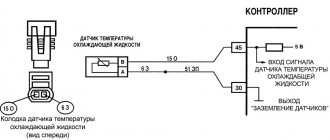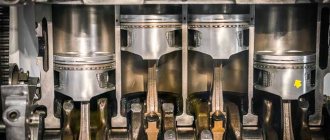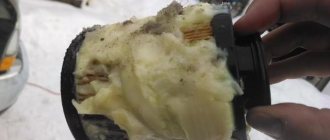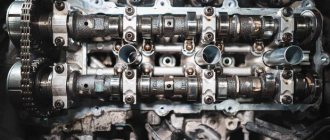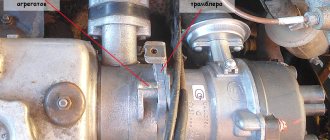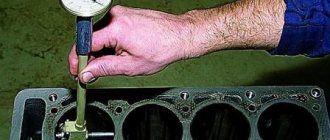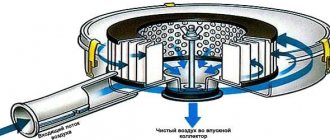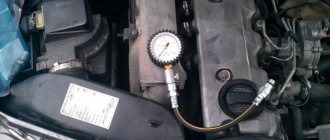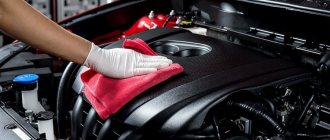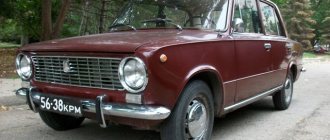What is engine hydraulic hammer
In a general sense, a water hammer is a sudden jump in pressure in a system filled with liquid, which leads to a change in flow velocity. This can cause cracks, splits and other damage to pipes, pumps and other pressure equipment.
The term “water hammer” in relation to the engine is not entirely correct, because here the situation is different. Water gets inside the cylinder block, which does not compress and prevents the cylinder from reaching the required point.
As a result, the engine stops due to damage to its elements. According to the rules, such a process implies the entry of liquid into the working cavity of the motor, and the term “water hammer” is used because of its greater convenience and connection with water. The water hammer process occurs as follows:
- Water enters the combustion chamber through the air filter/duct.
- When raised to the top, the cylinder encounters an incompressible fluid.
- The crank mechanism continues to press on the cylinder to reach the required point. As a result, the pressure increases 10-100 times.
- Connecting rod/rod damage, broken cylinder head studs, gasket damage and other problems occur. The most serious failure is a ruptured engine block.
To fully understand what engine hydraulic shock is, it is necessary to understand the prerequisites for its occurrence. There are two possible situations here:
- Overcoming a deep puddle at high speed. In this case, liquid under pressure flies into the air filter, and then into the working area of the engine.
- Driving through a water obstacle whose level is higher than the top point of the vehicle's air duct. “Drowned people” from Europe often come up with such problems.
A malfunction of the power unit cannot be ruled out when antifreeze or oil gets into the cylinder.
What is car engine water hammer and how to avoid it
Many experienced drivers are familiar with the unforeseen circumstance that occurs during high-speed passage of puddles. Moisture enters the combustion chamber through the air purification element. The integrity of the system suffers quite significant damage, as this occurs at the moment of the compression stroke of the combustible mixture. It is usually the person himself who acts incorrectly, but the exception is when there is an emergency on the road and you have to take a certain risk. Below you will learn more about what causes water hammer and how to check.
How to protect the engine
Order special equipment on our website: Special equipment rental in Russia
To avoid consequences, it is necessary to understand how to protect yourself from water hammer in the power unit and damage to its parts.
Follow simple rules:
- Do not drive through deep puddles at high speed, because in this case water is highly likely to be sucked into the combustion chamber. This must be done slowly and carefully.
- Adequately assess the capabilities of the machine and do not try to overcome deep water obstacles.
- Protect the air filter from water as much as possible.
- Monitor the health of the power unit. Few people know, but the cause of water hammer can be engine failure: lubricant or coolant getting into the working cylinder.
- If it is raining heavily outside and the puddles have turned into streams, it is better to stay at home and not take risks. In this case, you can protect yourself from troubles and unjustified testing of the vehicle’s capabilities. If you still cannot do without a trip, when crossing water obstacles, move at a speed of up to 10 km/h and only in first gear. If there is such an opportunity, it is better to avoid deep holes altogether.
Diesel engines deserve special attention. They are also susceptible to water hammer, and the consequences can be even more serious. So, due to the small combustion chamber, there is excessive pressure inside. As a result, in 95 out of 100 cases major repairs have to be made.
How does engine water hammer occur?
The damage caused depends on the ratio of the volume of liquid and the capacity of the combustion chamber. If there is not much of the first, the “knockout” goes unnoticed by the internal combustion engine (in this case, the node still suffers). In this case, troubles may overtake you at an unexpected moment - the vehicle will simply stop.
How to determine if there was an engine kick?
In the case described above, you most likely evacuate the faulty car to a car service center. There, specialists will open the “heart” of the car and find a crumpled/stuck spare part, a “dead” cylinder, a breakdown of the block, etc.
What do engine parts look like after water hammer?
An examination of the spare parts of the unit will determine what caused the malfunction. The failure will be confirmed if the following factors are detected:
- If there was little water and the car did not stall immediately, it is almost impossible to immediately determine the problem. In this situation, check the filter. The paper element will be deformed and the corrugation will be bent. With the synthetic version, traces of dried drops are looked for on the throttle valve and the walls of the air ducts.
- On the wall, above the area where the upper part of the moving part stops at the TDC position, there is a double border of carbon deposits.
- One connecting rod has failed - check the rest. When looking at the parts in the swing plane, the geometry is “wavy” (curvature is a sure sign of engine water hammer).
- A noticeable misalignment of the axes, in which an oval contact patch is visible on the connecting rod “skirt” and on the reverse side the same “mark” is located above the ring. In this case, the fire belt zone has a noticeable layer of “soot”, which is absent on the opposite side.
- An uneven edge of “soot” in the upper part of the cylinder (the characteristic shine at the bottom is evidence of water hammer on a gasoline engine).
- Shiny stripes appear on the edges of the liners - a trace of diagonal wear.
- The “dead” space above the piston is increased. The carbon deposits on the head are darker than the rest of the plaque.
What are the consequences of water hammer
The consequences of the piston hitting the gasket in the cylinder are different, so if the car was stationary and the engine was running exclusively at idle, it may simply stall. If the car was moving during the water hammer, the consequences will be more serious, since the pressure on the piston from the crankshaft will continue, creating greater forces. In this case, deformation and destruction of the liners, connecting rods, rings and crankshaft may occur.
When the piston reverses, small fragments of parts falling into the existing gap between the cylinder wall and the piston can pierce the wall or jam the piston, after which the engine cannot be restored. This is the most severe consequence of engine hydraulic shock, which is most dangerous for diesel units, since their combustion chamber volume is much smaller and the compression ratio is much higher.
When the car is traveling at low speed and the inertial forces on the crankshaft parts are not so great, the hydraulic shock impulse will not be sharp, which will help preserve the components from destruction.
In addition, the consequences of engine water hammer affect other engine parts. There are cases where strong pressure affected the deformation of the cylinder head. A sudden stop of the crankshaft during operation of the power unit leads to high mechanical stress, which acts on the drive belts and chains, as well as on their tension regulators. For this reason, they may stretch or tear, requiring replacement.
In such cases, the crankshaft is the last to suffer. It may become deformed or break due to the destruction of the piston or connecting rod gear. Destruction of the connecting rod head after a water hammer, as a rule, does not show signs of tarnish or overheating. Her appearance remains normal.
What to do after a water hammer
With any problem, the main thing is not to rush. Water hammer is detected by abruptly stopping the engine. After this, it will not start, which in fact should not be done.
First of all, inspect the air filter - it’s dry, which means the reason is elsewhere. But when it is wet, there is a high probability of water in the cylinder.
The consequences may be as follows:
- The reason for stopping the car is just water hammer.
- The engine jammed due to water hammer, and the cylinder block was also broken.
- The unit stalled and nothing serious happened.
The first two situations require calling a tow truck, but the latter is not critical. The engine can stall even before water hammer, even though moisture has penetrated into the combustion chamber, the internal combustion engine has already stopped working, and therefore serious complications have been avoided.
Here you can deal with the problem yourself. First you need to get rid of the wet air filter, then wipe the housing well to get rid of moisture.
Now unscrew the spark plugs and turn the crankshaft with the starter. This will allow water to drain from the cylinders. If the spark plugs do not come out, wait a while to allow water to drain into the engine crankcase.
Then start the internal combustion engine and let it run at idle speed.
It’s also worth checking the engine oil - moisture could also have gotten in there. This can be determined by color. A white tint indicates water in the oil and needs to be changed.
In order not to take unnecessary risks, it is better to call a tow truck to the nearest car service center. There the engine will dry, and specialists will assess the extent of the damage.
Causes
Motorists are sure that the problem of water hammer is relevant only for those who have recently been behind the wheel. Allegedly, only beginners make such mistakes, and this will never happen to experienced drivers.
But this is a big misconception. No one is fully insured against water hammer, which is why those who have spent many years behind the wheel without any serious incidents or mistakes also encounter this phenomenon.
It is extensive experience that often plays a cruel joke on a motorist. He is sure that he knows and can do everything, and therefore he really forgets basic things. Plus, transferring from one car to another, which differed in their characteristics and capabilities, leads to making banal mistakes.
There are 3 main reasons that lead to water hammer in the power plant.
- Deep puddles. If the driver often likes to drive at high speed through a fairly deep puddle, the likelihood of encountering a water hammer increases significantly. This is because a deep puddle allows water to easily penetrate the air filter. The combustion chamber is already very close to it. After the filter, there are practically no obstacles on the way into it.
- Water barriers. Not only SUV owners try to overcome various water obstacles. Even when a body of water, river or lake seems small, it’s worth taking risks only if you have full confidence in your car. Otherwise, the water level reaches the air intakes, the liquid follows into the air filter, and from there it is sent to the piston system of the power plant.
- Engine malfunctions. Even on a completely sunny day, in the absence of puddles and water barriers, there may be water in the cylinders. This can be explained by cracks and deformations of the cylinder head gasket. If this happens, the coolant acts as water, which leaks through the damaged gasket. When water hammer is caused precisely by a violation of the integrity of the engine structure, it often manifests itself when the engine starts.
These factors can be excluded. But not all drivers carefully monitor the condition of the engine, and sometimes they simply forget about the need to be careful when trying to overcome some puddles or other water obstacles.
How to determine engine hydraulic shock?
Even a few milliliters of H2O, if the piston is at TDC (top dead center), can damage the device. A breakdown is most often diagnosed by a sudden stop of the engine and water pouring out of the pipe.
Causes of engine water hammer
Moisture penetrates through the engine compartment into the air duct (for example, when crossing a river or passing through a deep puddle at speed). Penetration through fuel is impossible - the fuel system is equipped with several stages of filtration. Injectors also prevent the appearance of H2O in the cylinders.
What does engine hydraulic shock mean for sports cars? More often than not, these “cars” and their analogues are susceptible to the malfunction in question. The fact is that the zero-resistance element has a high throughput (it is not capable of retaining small fractions of H2O, so it is recommended to additionally use a special blocking oil). Also, air ducts on “sports cars” are usually mounted low. The general conclusion is to avoid deep puddles when driving.
Symptoms of water hammer
When powertrain parts encounter H2O, the parts are destroyed or deformed (reduced in length). How to find out if there was a water hammer in the engine? The presence of trouble is signaled by:
- H2O in the intake manifold;
- curved air filter bellows;
- a thick or uneven layer of soot (after a water hammer, the engine runs, but there is more “soot” on the head than in other places - the machine needs repair);
- deformed connecting rod;
- The crankshaft liners are worn around the edges.

